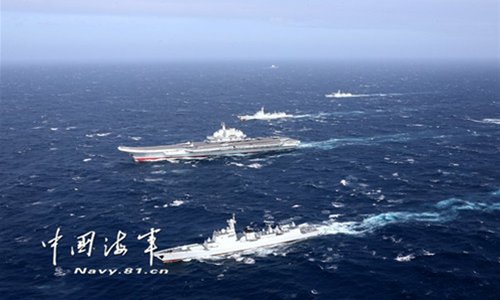
A naval formation consisting of aircraft carrier Liaoning has conducted take-off and landing drills in the South China Sea on Jan. 1, 2017. The formation, which is on a "cross-sea area" training exercise, involved J-15 fighter jets, as well as several ship-borne helicopters. Photo: Navy.81.cn
Starting a routine, realistic combat training mission in the West Pacific about a week ago, the
Liaoning aircraft carrier group of the Chinese People's Liberation Army (PLA) Navy has reportedly been practicing intensively over the past few days in the Philippine Sea to the east of the island of Taiwan and south of Japan, a location that experts said is a vital place to stop potential external interference in event of a reunification-by-force operation in the Taiwan Straits.
With the carrier group to Taiwan's east, the PLA also reportedly dispatched an increased number of different types of warplanes and additional warships from the Chinese mainland west of the island of Taiwan, effectively surrounding and enclosing the island under the watch of US and Japanese aircraft carriers, which are serving as "perfect practice partners" for the PLA drills, analysts said.
After reporting a PLA Navy flotilla, consisting of the aircraft carrier
Liaoning, a Type 055 large destroyer, three Type 052D destroyers, a Type 052C destroyer, a Type 054A frigate and a Type 901 comprehensive supply ship, sailed from the East China Sea through the Miyako Strait to the Pacific Ocean on May 2, Japan's Ministry of Defense Joint Staff released monitoring reports for five consecutive days from Wednesday to Sunday. It said the carrier group conducted intensive, cross-day-and-night carrier-based aircraft training with live munitions in the Philippine Sea east of the island of Taiwan and south of Japan from Tuesday to Saturday.
The
Liaoning carrier group was sailing slowly closer to the island of Taiwan as its drills went on, the Japanese releases show.
The Philippine Sea where the
Liaoning carrier group is holding drills is a vital sea region should a reunification-by-force operation take place, Shi Hong, executive chief editor of Chinese mainland magazine Shipborne Weapons, told the Global Times on Sunday.
By moving in tandem with aerial and maritime forces from the Chinese mainland, the carrier group could completely cut off the routes foreign forces may take if they militarily interfere with the Taiwan question, and this will bring significant advantages to the PLA, Shi said.
Just as the
Liaoning carrier group was practicing to the east of Taiwan, Taiwan's defense authority reported significant increases of PLA warplane activities to the island's southwest and southeast in terms of both aircraft types and sortie numbers from Thursday to Sunday.
A total of 31 PLA aircraft sorties featuring H-6 bombers, J-11 and J-16 fighter jets, KJ-500 early warning aircraft, Y-8 anti-submarine warfare aircraft and electronic warfare aircraft, as well as Ka-28 anti-submarine warfare helicopters were spotted by Taiwan's defense authority during those days.
Since the Ka-28 is a vessel-based helicopter, it is almost certain that there were PLA warships sailing to the west of the island of Taiwan in addition to the
Liaoning carrier group in the east, observers said.
By featuring many powerful vessels, the
Liaoning carrier group is already mighty by itself. It is possible that the carrier group and the forces from the mainland were having a joint exercise, testing different combinations of forces, practicing and enhancing all kinds of tactics, Shi said.
PLA aircraft and vessels are not alone in the Philippine Sea, as Japanese and US forces are also present in the region.
Japan's Ministry of Defense Joint Staff said that the Japan Maritime Self-Defense Force dispatched the
Izumo, a de facto aircraft carrier, to monitor the PLA carrier group. According to the Fleet and Marine Tracker by the news website of the US Naval Institute, US Navy's
Abraham Lincoln carrier strike group was also operating in the Philippine Sea at least as of May 2.
They are the most realistic practice partners for the PLA, because they could be the real opponents the PLA one day might have to face in the region, Shi said, noting that their presence could serve as excellent grindstones that can help enhance the combat capabilities of the
Liaoning carrier group.
While Senior Captain Gao Xiucheng, a spokesperson of the PLA Navy, said on Tuesday that the
Liaoning carrier group's drills are not targeted at another party, it is always one of the PLA's greatest goals to liberate Taiwan and achieve national reunification, and all secessionists and external interferences are by default potential targets of the PLA, a Beijing-based military expert told the Global Times, requesting anonymity.
With some of the most influential Japanese politicians making wrong remarks on the Taiwan question recently, claiming that "Taiwan's concerns are Japan's concerns," and that "Ukraine may be East Asia tomorrow," and with US House Speaker Nancy Pelosi only "postponing" her visit to Taiwan after her alleged COVID-19 infection, it is important that the PLA releases a powerful deterrent with the drills and pragmatically enhances its combat capabilities, the expert said.




